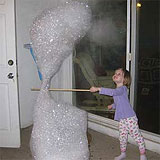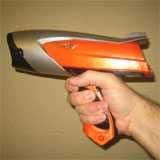How to Test the Effectiveness of Beer Cozies
How effective is a beer cozy at keeping a beer cold?
I did this experiment all wrong.
Well, the experiment was conducted well, but it was the wrong experiment.
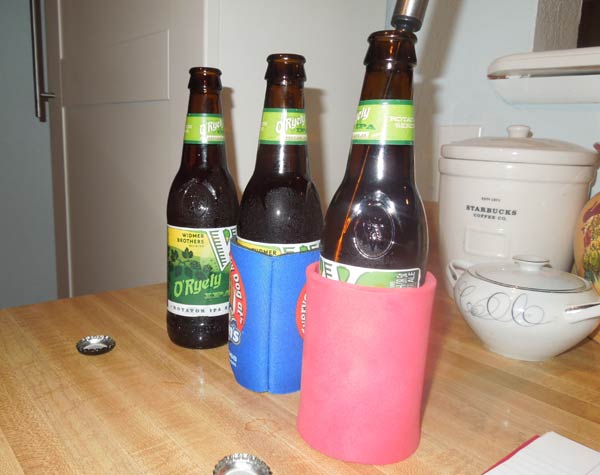
I wanted to figure out how well those foam beer insulators work to keep your beer cold. I started with three cold beers, one with no insulator, one with a neoprene insulator and one with a foam insulator. This experiment would reveal three different rates of warming, and allow me to conclude how effective these beer cozies are. This was the wrong experiment.

1. Three bottles of beer on the counter.
Despite being in the fridge together for hours, the beer inside the bottles was not an identical temperature when I started. The start temperatures were 39°F, 38°F and 43°F.
I wrapped one bottle in a thin neoprene beer cozy from Aaron's Lease-to-Own. For another I used a soft foam insulator. The third was the control bottle. It had no sleeve of insulation.
Forty eight minutes later, I tested the bottles again. They had warmed. the bottle without insulation had warmed up to 51°F. That was an increase of 12°F. The beer protected by neoprene had only risen to 47°F, an increase of 9°F. Finally, the bottle in the foam sleeve had risen to 50°F, but this bottle started at the warmest, so 50° was an increase of just 7°F.
Yes. My suspicions, as well as those of everyone who has ever used a beer cozy were correct. Beer cozies help keep your beer cold.
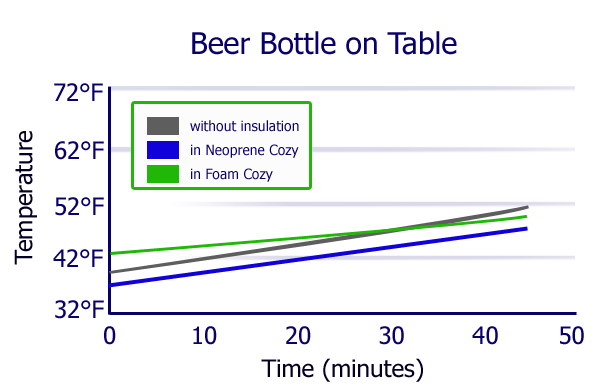
But, this wasn't realistic. Beer doesn't just sit on the counter. You hold it. What I really needed was a test of how effective the beer insulator was at protecting the cold beer from the heat of your hands! Another test was in order. Unfortunately, this was also the wrong experiment.
2. Two bottles of beer in hands.
Starting with two very cold beers (34°F), I opened them and prepared to hold them for almost an hour. I wrapped one beer in a neoprene beer cozy and left one unprotected. I was concerned that the ice-cold beer might become painful to hold for an extended period of time, but seemed like a problem I could drink my way out of.
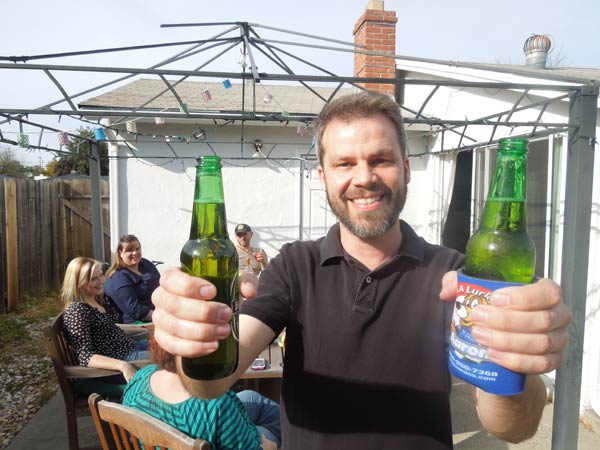
Two handfuls of beer and not a drop to drink.
After 10 desiccating minutes, I went ahead and started drinking some of the beer... in equal amounts from both bottles.
After 30 minutes, Dave helped me check the temperatures.
The insulated beer had warmed up, it was now 44.8°F, representing an increase of about 11°F. The non-insulated beer had also warmed up. It was now 58.5°F! An increase of 24°F in a half-hour!

The beer cozy was definitely doing its job! Holding an uninsulated beer was for suckers!
After 50 minutes, the insulated beer was up to 53°F. The unaided beer was at room temperature, 71°F, and officially gross-tasting.

Unfortunately, this was also the wrong experiment.
Beer cozies weren't invented for beer bottles. They were invented for beer CANS. Bottles already have a reasonable shield of insulation: 3 mm of glass. Beer cans are paper-thin containers manufactured from a first-class heat-conducter: aluminum.
Cans chill lightening-quick in your fridge, but they are highly-susceptible to heat transfer from your 98°F grip.
I needed to measure the effect of a beer cozie on CANS.

No problem.
3. Two cans of beer in hands.
This was the right experiment.
I opened two beer cans simultaniously, one with a foam beer cozy, one without. I held the two beers almost continuously for 30 minutes.

The heat from my hands transferred readiliy into the uninsulated beer can. My warm hand was an invitation to rise to the temperature of my blood, and the uninsulated can didn't have a choice but to accept that invitation.
In 30 minutes, the plain can rose 25°F. It went from a delicious 43°F to a lip-curling 68°F! This was almost a one-degree temperature increase per minute!

The insulated can fared much better, staying below 48°F the whole time.
The insulated can went from 43° to 48°F, an increase of just 5 degrees over 30 minutes. Amazing! The soft foam had stopped heat transfer 5x better than a plain aluminum can.
Summary
I can't remember the last time I had to do three seperate experiments to reach a kind of obvious solution. I guess there are two kinds of experiments, the kind where you figure out what is happening, and the kind where you figure out how much of something is happening.
In these experiments, here is what I found: If you don't use a beer cozy, your can of beer is warming up at a rate of about one degree per minute. That means you have to 1) drink the beer quickly, or 2) risk having a disgustingly warm beer. Choose wisely.
backwash experiment | cooling beer experiment | coldest drink in town
Cockeyed home page | Contact | Terms and Conditions | Updated April 2, 2013 Copyright 2013 Cockeyed.com












